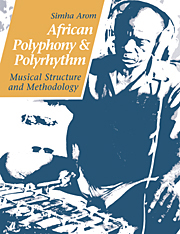Book contents
- Frontmatter
- Contents
- List of illustrations
- Foreword by György Ligeti
- Preface
- Acknowledgements
- BOOK I THE MUSIC OF THE CENTRAL AFRICAN REPUBLIC
- BOOK II AFRICAN POLYPHONIC MUSIC
- BOOK III TECHNICAL TOOLS: METHODS OF RECORDING POLYPHONIC MUSIC FOR TRANSCRIPTION
- BOOK IV THEORETICAL TOOLS
- BOOK V THE ORGANISATION OF TIME IN AFRICAN MUSIC
- 1 A brief survey of Western rhythmics
- 2 Towards a precise terminology
- 3 African rhythmics
- BOOK VI STRUCTURAL PRINCIPLES AND THEIR APPLICATION
- Conclusion
- Bibliography
3 - African rhythmics
Published online by Cambridge University Press: 27 January 2010
- Frontmatter
- Contents
- List of illustrations
- Foreword by György Ligeti
- Preface
- Acknowledgements
- BOOK I THE MUSIC OF THE CENTRAL AFRICAN REPUBLIC
- BOOK II AFRICAN POLYPHONIC MUSIC
- BOOK III TECHNICAL TOOLS: METHODS OF RECORDING POLYPHONIC MUSIC FOR TRANSCRIPTION
- BOOK IV THEORETICAL TOOLS
- BOOK V THE ORGANISATION OF TIME IN AFRICAN MUSIC
- 1 A brief survey of Western rhythmics
- 2 Towards a precise terminology
- 3 African rhythmics
- BOOK VI STRUCTURAL PRINCIPLES AND THEIR APPLICATION
- Conclusion
- Bibliography
Summary
ON MUSIC BASED ON THE TACTUS
African cross-rhythm is extremely complex, and is characterised essentially by the permanent sense of tension it creates: different interwoven rhythmic figures are repeated cyclically and uninterruptedly. The interlocked structure may involve irregular accentuation as well, making it extremely difficult for even the trained listener to analyse it by ear. This is what Apel (1970: 214) calls ‘conflicting rhythmic patterns’.
No matter how complex it may be, however, African rhythm always has a simple ultimate reference: the pulsation as defined above, whose function is similar to that of the Medieval tactus. African practice thus resembles the practice in use in the West during the Middle Ages and the Renaissance, when the temporal organisation of music was based solely on this neutral, unmarked, intrinsic element.
Let us recall that the tactus as mere unit of duration had the sole function of providing the performers with equidistant reference points. As Schünemann says, that is why ‘in olden times, the person beating time could only specify the tempo, not accentuation … He beat regularly with upward and downward motions of the hand like a metronome’ (1913: 54). Given the strictly metric (in the primary sense of the term) nature of this governing principle, Auda says, ‘In the thirteenth as in the sixteenth century, the laws of metric measure and rhythmic measure were the same’ (1965: 141).
The tactus made it possible to obtain a direct coordination of the durations in all the parts of a polyphonic work without recourse to an intermediate level in the hierarchy: ‘Until about the seventeenth century, there were no two-, three-, or four-beat measures, only a succession of tactus corresponding more or less to what we call a “beat” today’ (Chailley 1967: 102).
- Type
- Chapter
- Information
- African Polyphony and PolyrhythmMusical Structure and Methodology, pp. 206 - 212Publisher: Cambridge University PressPrint publication year: 1991



